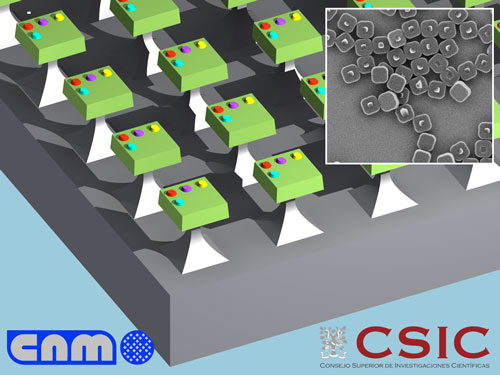| Posted: Dec 29, 2015 | |
Multiplexed planar array analysis from within a living cell |
|
| (Nanowerk Spotlight) Multiplex biological assays allow simultaneous detection of numerous analytes such as proteins and other molecular components in a single sample. Planar array chips consist of a collection of multiple independent and ordered sensing features immobilized on a solid support, allowing parallel assays. These devices have been a revolution in the field of molecular analysis. | |
| In order to reduce the size of the required samples and speed up detection times, suspended arrays of particles were developed. Here, captured molecules are immobilized onto a microsphere and captured analytes are detected mostly using flow cytometry. However, the advantage of parallel assays in a single device is lost as each microsphere bears only a single molecular probe. | |
| Consequently, there has been a great effort by the scientific community to develop a technique that allows several probes on the same particle. | |
| "Considering that the size of molecular probes in these arrays remains a critical property for many biological applications, there is a continuous need to miniaturize monodisperse particles for further sample reduction and higher throughput," Dr. José Antonio Plaza, who leads the Micro- and NanoTools Group at Instituto de Microelectrónica de Barcelona IMB-CNM (CSIC), tells Nanowerk. "In our new work, we introduce suspended planar-array (SPA) chips whose in situ capabilities with a spatial molecular-probe arrangement combine the advantages of both suspended arrays and planar arrays." | |
| This novel technology, published in a paper in the December 9, 2015 online edition of Advanced Materials ("Suspended Planar-Array Chips for Molecular Multiplexing at the Microscale"), opens the way towards the multiplexed detection of intracellular biological parameters using a single device in dramatically reduced volumes, such as a living HeLa cell. This work has been done in collaboration with scientists from the Universitat de Barcelona (UB) and the Institut de Bioenginyeria de Catalunya (IBEC) lead by Lluïsa Pérez-García, and the Centro de Investigaciones Biológicas CIB(CSIC) lead by Teresa Suárez. | |
| The team miniaturized the volume of a regular silicon planar array by a factor of more than 1 billion. This allowed them to demonstrate multiplexed analysis on a 9 (3x3x1) µm3 planar array chip. The chip's volume represents only about 0.35% of the total volume of a typical HeLa cell. | |
| In a previous Nanowerk Spotlight ("Future bio-nanotechnology will use computer chips inside living cells") we reported on the group's work that showed that chips with similar dimensions could be easily internalized inside living HeLa cells and affect neither the cell viability nor the cell division. In follow-up work, the researchers demonstrated a nanomechanical chip that can be internalized to detect intracellular pressure changes within living cells, enabling an interrogation method based on confocal laser scanning microscopy ("Silicon chips inserted into living cells can feel the pressure"). | |
| "The potential applications of these devices are the molecular multiplexing of extraordinary small volumes in a single chip, to perform multiple molecular analysis in really small volumes simultaneously," says Plaza. "Among them, one of the most fascinating applications is in cell biology. The volume of these chips is so small that they can be internalized inside living cells. Cells are usually analyzed in planar arrays chips. We have succeeded in achieving the opposite: this is the first time a multiplex planar array goes inside a living cell." | |
| The key to fabricating these devices is the combination of a manufacturing technology commonly used in microchip production with a molecular printing technique – polymer pen lithography (PPL). The first one offers a high-throughput of millions of micron-sized chips while the latter offers higher molecular-pattern flexibility in small dimensions. | |
| In their work, the team used PPL to pattern molecules directly on the area-restricted surfaces of the anchored chips. | |
 |
|
| This cartoon shows the molecular multiplexed chips anchored to the silicon wafer before releasing. Colored dots represent different molecular probes. (INSET) A SEM image of the suspended chips after releasing. (Image: José A. Plaza, CSIC) | |
| Some of the potential applications of this chip are the determination of physicochemical intracellular parameters related to genetic determinants of diseases; cellular-function modulators; or dynamic responses of the cell in vivo. | |
| In their experiments, the scientists demonstrated multiplexed detection of the intracellular pH changes in HeLa cells. In addition, their results showed that cell viability remains unaffected by the chip. | |
| Plaza and his collaborators are now planning to develop chips with new molecular probes that can detect intracellular molecules or even physicochemical parameters relevant for cell functioning, with the added value that this will be done inside intact living cells and by a single device. | |
| "Cells are complex systems," says Plaza. "Traditionally, cell biology has been mainly based on biochemical studies. However, recently clear evidence emerged that cells' biochemistry is coupled to physical cues, which are obvious in, for instance, mechanotransduction. Thus, the possibility to use intracellular chips to perform biochemical and biophysical studies simultaneously opens a new venue of possibilities in fundamental studies of cell biology." | |
 By
Michael
Berger
– Michael is author of three books by the Royal Society of Chemistry:
Nano-Society: Pushing the Boundaries of Technology,
Nanotechnology: The Future is Tiny, and
Nanoengineering: The Skills and Tools Making Technology Invisible
Copyright ©
Nanowerk LLC
By
Michael
Berger
– Michael is author of three books by the Royal Society of Chemistry:
Nano-Society: Pushing the Boundaries of Technology,
Nanotechnology: The Future is Tiny, and
Nanoengineering: The Skills and Tools Making Technology Invisible
Copyright ©
Nanowerk LLC
|
|
|
Become a Spotlight guest author! Join our large and growing group of guest contributors. Have you just published a scientific paper or have other exciting developments to share with the nanotechnology community? Here is how to publish on nanowerk.com. |
|
